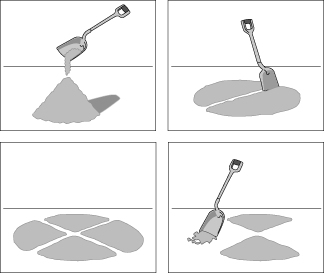| Monthly Tech-Tip | No tracking! No ads! | |
A Low Cost Tester of Glaze Melt Fluidity
A One-speed Lab or Studio Slurry Mixer
A Textbook Cone 6 Matte Glaze With Problems
Adjusting Glaze Expansion by Calculation to Solve Shivering
Alberta Slip, 20 Years of Substitution for Albany Slip
An Overview of Ceramic Stains
Are You in Control of Your Production Process?
Are Your Glazes Food Safe or are They Leachable?
Attack on Glass: Corrosion Attack Mechanisms
Ball Milling Glazes, Bodies, Engobes
Binders for Ceramic Bodies
Bringing Out the Big Guns in Craze Control: MgO (G1215U)
Can We Help You Fix a Specific Problem?
Ceramic Glazes Today
Ceramic Material Nomenclature
Ceramic Tile Clay Body Formulation
Changing Our View of Glazes
Chemistry vs. Matrix Blending to Create Glazes from Native Materials
Concentrate on One Good Glaze
Copper Red Glazes
Crazing and Bacteria: Is There a Hazard?
Crazing in Stoneware Glazes: Treating the Causes, Not the Symptoms
Creating a Non-Glaze Ceramic Slip or Engobe
Creating Your Own Budget Glaze
Crystal Glazes: Understanding the Process and Materials
Deflocculants: A Detailed Overview
Demonstrating Glaze Fit Issues to Students
Diagnosing a Casting Problem at a Sanitaryware Plant
Drying Ceramics Without Cracks
Duplicating Albany Slip
Duplicating AP Green Fireclay
Electric Hobby Kilns: What You Need to Know
Fighting the Glaze Dragon
Firing Clay Test Bars
Firing: What Happens to Ceramic Ware in a Firing Kiln
First You See It Then You Don't: Raku Glaze Stability
Fixing a glaze that does not stay in suspension
Formulating a body using clays native to your area
Formulating a Clear Glaze Compatible with Chrome-Tin Stains
Formulating a Porcelain
Formulating Ash and Native-Material Glazes
G1214M Cone 5-7 20x5 glossy transparent glaze
G1214W Cone 6 transparent glaze
G1214Z Cone 6 matte glaze
G1916M Cone 06-04 transparent glaze
Getting the Glaze Color You Want: Working With Stains
Glaze and Body Pigments and Stains in the Ceramic Tile Industry
Glaze Chemistry Basics - Formula, Analysis, Mole%, Unity
Glaze chemistry using a frit of approximate analysis
Glaze Recipes: Formulate and Make Your Own Instead
Glaze Types, Formulation and Application in the Tile Industry
Having Your Glaze Tested for Toxic Metal Release
High Gloss Glazes
Hire Us for a 3D Printing Project
How a Material Chemical Analysis is Done
How desktop INSIGHT Deals With Unity, LOI and Formula Weight
How to Find and Test Your Own Native Clays
I have always done it this way!
Inkjet Decoration of Ceramic Tiles
Is Your Fired Ware Safe?
Leaching Cone 6 Glaze Case Study
Limit Formulas and Target Formulas
Low Budget Testing of Ceramic Glazes
Make Your Own Ball Mill Stand
Making Glaze Testing Cones
Monoporosa or Single Fired Wall Tiles
Organic Matter in Clays: Detailed Overview
Outdoor Weather Resistant Ceramics
Painting Glazes Rather Than Dipping or Spraying
Porcelain Tile, Vitrified Tile
Rationalizing Conflicting Opinions About Plasticity
Ravenscrag Slip is Born
Recylcing Scrap Clay
Reducing the Firing Temperature of a Glaze From Cone 10 to 6
Setting up a Clay Testing Program in Your Company
Simple Physical Testing of Clays
Single Fire Glazing
Soluble Salts in Minerals: Detailed Overview
Some Keys to Dealing With Firing Cracks
Stoneware Casting Body Recipes
Substituting Cornwall Stone
Super-Refined Terra Sigillata
The Chemistry, Physics and Manufacturing of Glaze Frits
The Effect of Glaze Fit on Fired Ware Strength
The Four Levels on Which to View Ceramic Glazes
The Majolica Earthenware Process
The Potter's Prayer
The Right Chemistry for a Cone 6 MgO Matte
The Trials of Being the Only Technical Person in the Club
The Whining Stops Here: A Realistic Look at Clay Bodies
Those Unlabelled Bags and Buckets
Tiles and Mosaics for Potters
Toxicity of Firebricks Used in Ovens
Trafficking in Glaze Recipes
Understanding Ceramic Materials
Understanding Ceramic Oxides
Understanding Glaze Slurry Properties
Understanding the Deflocculation Process in Slip Casting
Understanding the Terra Cotta Slip Casting Recipes In North America
Understanding Thermal Expansion in Ceramic Glazes
Unwanted Crystallization in a Cone 6 Glaze
Using Dextrin, Glycerine and CMC Gum together
Volcanic Ash
What Determines a Glaze's Firing Temperature?
What is a Mole, Checking Out the Mole
What is the Glaze Dragon?
Where do I start in understanding glazes?
Why Textbook Glazes Are So Difficult
Working with children
Particle Size Distribution of Ceramic Powders
Description
Understanding the theory behind sieve selection, how to properly sample a powder and how to carry out a particle size distribution test can give you valuable information about a material.
Article
Particle size is one of the most important properties of clays and ceramic minerals. One gram of powdered material can have billions of particles with a surface area of many square meters. A knowledge of not only the average size but how the sizes are distributed, can be very valuable.
The sieve analysis test I recommend is performed by slurrying and soaking a clay sample in water and then washing it through a series of successively finer and finer interlocking screens (this can be done on a plastic or lump clay material by drying and then slaking it thoroughly in water first). This test is important in monitoring consistency of clay and material powders (unlike most of the other tests I recommend, this one does require that you purchase equipment you cannot easily make).
Particle size tests are important in many industries (e.g. cement) and sieves have thus become highly standardized. Usually screens are chosen so that each has an opening with double the area of the one below it. This is referred to as a series because the width of the 'root of two' opening is the root of two (or 1.414) times that of the previous. Screens can be referenced in mesh sizes (a 100 mesh screen has about 100 wires per inch) or dimensions of the opening. They are calibrated from a standard 200 mesh having an opening of 0.0029". A good brass sieve can cost $150 or more and must be treated with care.
Methods of recording and presenting the data are very important and sieve manufacturers provide helpful books. The W.S. Tyler company, for example, is a manufacturer of quality sieves and publishes a very interesting book called 'Testing Sieves and Their Uses'.
Insight-live.com defines a test abbreviated 'SIEV', it clearly defines the procedure to use to perform a particle size appraisal of a material. It also provides information on the reasons why the test should be a part of your standard testing regimen.
One of the most important aspects of doing sieve analysis tests is the matter of selecting a representative specimen to test. It does little good to graph in detail an analysis if the specimen is not typical. The diagram shown here illustrates one method.
Taking A Representative Specimen

In addition to controlling material consistency and spotting impurities, sieve analysis tests are valuable in making formulation decisions. For example, the strongest and best clays are made dense by a good distribution of particle sizes at plus 325 mesh. In this way, there is a good packing in the dried matrix and therefore maximum green strength and minimum low temperature absorption. Bodies with a distribution of particle sizes tend to be comparatively stronger in the fired state and tend to have more robust working and drying properties than those made from the same materials ground to a fine mesh size. Particles of 100 mesh or finer do not generally have a noticeable texture (they feel smooth) but are easily detected by a sieve analysis.
A sieve analysis test can also alert you to trouble. It will show if coarser or agglomerated particles are present in a body presenting the danger of pinholing and premature bloating (especially in oxidation firing if the particles are "undesirables" e.g. coal, plaster, concretions). The open nature of a coarser body can also invite pinholing and pitting in less viscous glazes.
Clays with sand or grog additions in a very fine plastic particle size matrix often lack intermediate sizes and can micro-crack around each large particle. This phenomenon, although invisible to the eye, is evident not only by the dead 'thud' when a piece is tapped with a pen but by a sieve analysis of the raw material. A sieve analysis can be employed to incorporate a coarser clay or a finer grog or sand.
Related Information
A root-of-two series of test sieves

This picture has its own page with more detail, click here to see it.
The coarsest screen is at the top, the finest on the bottom. The top one has an opening of 425 microns (thus 425 micron and finer particles will pass through it, +425 micron particles will not). Its opening area is 180,000 square microns (425x425). Going downward, the openings have areas half that of the one above (thus, for the second, the opening area is 300x300=90,000 microns). Structural products industries, like brick, measure coarser particles than this, using 10-70 mesh. Using this series one can produce a standard measurement of the distribution of particle sizes in a material powder. The finer sieves (from 100-325) are only practical for wet processing (where the powder is water washed through the stack). In Insight-live the SIEV test (water washed) uses this series of sieves.
This is what labs use to measure particle size

This picture has its own page with more detail, click here to see it.
To measure particle size in a slurry or powder you need sieves. This is the most popular type used in labs. They are made from brass by a company named Tyler. The range of screen sizes for testing particle size is very wide (obvious here: the top screen has an opening of 56 mm, the bottom one 0.1 mm - the wires are almost too small to see). You can often buy these used on Ebay for a lot less than new ones, search for "tyler sieve". The finer sieves (especially 200) are fragile and more easily ripped. For potters it is good to have a 50, 100 and 150.
Links
| Projects |
Minerals
|
| Projects |
Materials
|
| By Tony Hansen Follow me on        |  |
Got a Question?
Buy me a coffee and we can talk

https://digitalfire.com, All Rights Reserved
Privacy Policy
